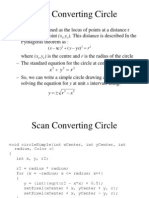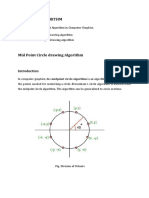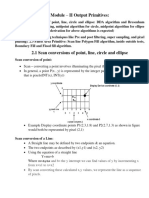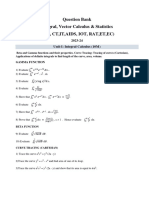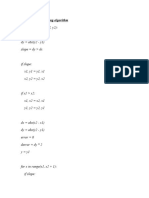0 ratings0% found this document useful (0 votes)
2 viewsCircle Drawing Algorithm
The document discusses methods for scan-converting circles and ellipses, highlighting the use of symmetry to plot points efficiently. It details two mathematical definitions for circles (polynomial and trigonometric) and outlines Bresenham's algorithm for approximating circles in raster graphics. Additionally, it explains similar methods for defining and scan-converting ellipses using both polynomial and trigonometric approaches.
Uploaded by
nkamath968Copyright
© © All Rights Reserved
Available Formats
Download as PPTX, PDF, TXT or read online on Scribd
0 ratings0% found this document useful (0 votes)
2 viewsCircle Drawing Algorithm
The document discusses methods for scan-converting circles and ellipses, highlighting the use of symmetry to plot points efficiently. It details two mathematical definitions for circles (polynomial and trigonometric) and outlines Bresenham's algorithm for approximating circles in raster graphics. Additionally, it explains similar methods for defining and scan-converting ellipses using both polynomial and trigonometric approaches.
Uploaded by
nkamath968Copyright
© © All Rights Reserved
Available Formats
Download as PPTX, PDF, TXT or read online on Scribd
You are on page 1/ 12
Scan Converting a Circle
A circle is a symmetrical figure.
Any circle-generating algorithm
can take advantage of the circle's
symmetry to plot eight points for
each value that the algorithm
calculates. Eight-way symmetry is
used by
reflecting each calculated point
around each 45° axis. For
example, if point 1 in Fig. 3-4
were calculated
with a circle algorithm, seven
more points could be found by
reflection.
Defining a Circle
There are two standard methods of mathematically defining a
circle centered at the origin. The first method defines a circle
with the second-order polynomial equation
y2=r2-x2
where x = the x coordinate
y = the y coordinate
r = the circle radius
With this method, each x coordinate in the sector from 90° to
45°, is found by stepping x from 0 to
r/sqrt(2), and each y coordinate is found by evaluating sqrt(r2 — x2)
for each step of x.
This is a very inefficient method, however, because for each
point both x and r must be squared and subtracted from each
other; then the square root of the result must be found.
Defining a Circle
The second method of defining a circle
makes use of trigonometric functions (see
Fig. 3-6):
x = r cos ɵ y = r sin ɵ
where ɵ = current angle
r = circle radius
x = x coordinate
y = y coordinate
By this method, ɵ is stepped from ɵ to Π/4,
and each value of x and y is calculated.
However, computation of the values of sin
ɵ and cos ɵ is even more time-consuming
than the calculations required by the first
method.
Generating a circle using
Polynomial Method
1. Set the initial variables: r = circle radius; (h, k) = coordinates of the circle
center; x = 0; i = step size;
2. Test to determine whether the entire circle has been scan-converted. If x > xend,
stop.
3. Compute the value of the y coordinate, where y = sqrt(r2 — x2).
4. Plot the eight points, found by symmetry with respect to the center (h, k), at the
current (x, y) coordinates:
Plot(x + h, y + k) Plot(-x + h, -y + k)
Plot(y + h, x + k) Plot(-y + h, -x + k)
Plot(-y + h, x + k) Plot(y + h, -x + k)
Plot(-x + h, y + k) Plot(x + h, -y + k)
5. Increment x: x = x + i.
6. Go to step 2.
Scan Convert a Circle using
Trigonometric Method
1. Set the initial variables: r = circle radius; (h, k) = coordinates of the circle center; i = step
size;
ɵend = Π/4 (radians = 45°); ɵ = 0.
2. Test to determine whether the entire circle has been scan-converted. If ɵ > ɵ end , stop.
3. Compute the value of the x and y coordinates:
x = r cos(ɵ) y = r sin(ɵ)
4. Plot the eight points, found by symmetry with respect to the center (h, k), at the current
(x, y) coordinates:
Plot(x + h, y + k) Plot(-x + h, -y + k)
Plot(y + h,x + k) Plot(-y + h, -x + k)
Plot(-y + h, x + k) Plot(y + h,-x + k)
Plot(-x + h, y + k) Plot(x + h, -y + k)
5. Increment : ɵ = ɵ + i.
6. Go to step 2.
Bresenham's Circle Algorithm
Scan-converting a circle using
Bresenham's algorithm works as follows.
The best approximation of the true circle
will be described by those pixels in the
raster that fall the least distance from
the true circle. Examine Fig. 3-8. Notice
that, if points are generated from 90°
and 45°,each new point closest to the
true circle can be found by taking either
of two actions:
(1) move in the x direction one unit or
(2) move in the x direction one unit and
move in the negative y direction one unit.
Therefore, a method of selecting between
these two choices is all that is necessary to
find the points closest to the true circle.
Bresenham's Circle Algorithm
Assume that (xi,yi) are the coordinates of the last scan-
converted pixel upon entering step i.
Let the distance from the origin to pixel T squared
minus the distance to the true circle squared = D(T).
Then let the distance from the origin to pixel S squared
minus the distance to the true circle squared = D(S). As
the coordinates of T are (xi + 1,yi) and those of S are (xi
+ 1,yi-1), the following expressions can be developed:
This function D provides a relative measurement of the
distance from the center of a pixel to the true circle.
Since D(T) will always be positive (T is outside the true
circle) and D(S) will always be negative (S is inside the
true circle), a decision variable di may be defined as
follows:
When di < 0, we have |D(T)| < |D(S)| and pixel T is
chosen. When di > 0, we have |D(T)| > |D(S)| and pixel
S is selected.
Bresenham's Circle Algorithm
1. Set the initial values of the variables: (h, k) = coordinates of circle center; x =
0; y = circle radius r and d = 3 - 2r.
2. Test to determine whether the entire circle has been scan-converted. If x > y,
stop.
3. Plot the eight points, found by symmetry with respect to the center (h, k), at
the current (x, y) coordinates:
Plot(x + h, y + k) Plot(-x + h, -y + k)
Plot(y + h, x + k) Plot(-y + h, -x + k)
Plot(-y + h, x + k) Plot(y + h,-x + k)
Plot(-x + h, y + k) Plot(x + h, -y + k)
4. Compute the location of the next pixel.
If d < 0, then d = d + 4x + 6 and x = x + 1.
If d > 0, then d = d + 4(x - y) + 10, x = x + 1, and y = y - 1.
5. Go to step 2.
Defining an Ellipse using Polynomial Method
The ellipse, like the circle, shows symmetry. In the case of an
ellipse, however, symmetry is four- rather than eight-way.
There are two methods of mathematically defining a ellipse.
The polynomial method of defining an ellipse (Fig. 3-9) is given
by the expression
where (h, k) = ellipse center
a = length of major axis
b = length of minor axis
When the polynomial method is used to define an ellipse, the
value of x is incremented from h to a. For each step of x, each
value of y is found by evaluating the expression
This method is very inefficient, however, because the squares
of a and (x — h) must be found; then floating- point division of
(x — h) by a2 and floating-point multiplication of the square
root of [1 — (x — h) /a2] by b must be performed
Scan Converting an Ellipse using
Polynomial Method
1. Set the initial variables: a = length of major axis; b = length of minor
axis; (h, k) = coordinates of ellipse center; x = 0; i = step size; xend = a.
2. Test to determine whether the entire ellipse has been scan-converted. If
x > xend, stop.
3. Compute the value of the y coordinate:
4. Plot the four points, found by symmetry, at the current (x, y)
coordinates:
Plot(x + h, y + k) Plot(-x + h, -y + k)
Plot(-x + h, y + k) Plot(x + h, -y + k)
5. Increment x: x = x + i.
6. Go to step 2.
Defining Ellipse using
Trigonometric Method
A second method of defining an ellipse makes use of trigonometric
relationships. The following equations define an ellipse
trigonometrically:
x = a cos(ɵ) + h and y = b sin(ɵ) + k
where (x, y) = the current coordinates
a = length of major axis
b = length of minor axis
ɵ = current angle
(h,k) = ellipse center
For generation of an ellipse using the trigonometric method, the
value of ɵ is varied from 0 to n/2
radians (rad). The remaining points are found by symmetry.
While this method is also inefficient and thus generally too slow for
interactive applications, a lookup table containing the values for
sin(ɵ) and cos(ɵ) with ɵ ranging from 0 to n/2 rad can be used.
Scan Converting an Ellipse using
Trigonometric Method
1. Set the initial variables: a = length of major axis; b = length of minor axis;
(h, k) = coordinates of ellipse center; i = counter step size; ɵend = n/2; ɵ = 0.
2. Test to determine whether the entire ellipse has been scan-converted. If ɵ
> ɵend, stop.
3. Compute the values of the x and y coordinates:
x = a cos(ɵ) y = b sin(ɵ)
4. Plot the four points, found by symmetry, at the current (x, y) coordinates:
Plot(x + h, y + k) Plot(-x + h, -y + k)
Plot(-x + h, y + k) Plot(x + h, -y + k)
5. Increment 8: 8 = 8 + i.
6. Go to step 2
You might also like
- DDA & BRESENHAMS, Circle (Mid Point Approch)No ratings yetDDA & BRESENHAMS, Circle (Mid Point Approch)36 pages
- TOPIC IV_V_Line Drawing Algorithms and Primitive OutputsNo ratings yetTOPIC IV_V_Line Drawing Algorithms and Primitive Outputs9 pages
- Submitted To Submitted by Kunal Malik 4002: DR - Kiran Malik AP (CSE Dept.)No ratings yetSubmitted To Submitted by Kunal Malik 4002: DR - Kiran Malik AP (CSE Dept.)43 pages
- Presentation On Line Drawing AlgorithmsNo ratings yetPresentation On Line Drawing Algorithms32 pages
- Computer Grahics: Ii B.Tech Cse I SemesterNo ratings yetComputer Grahics: Ii B.Tech Cse I Semester170 pages
- Applications of Elliptic Curves Over Finite Fields: University of New BrunswickNo ratings yetApplications of Elliptic Curves Over Finite Fields: University of New Brunswick8 pages
- Computer Graphics Circle Drawing TechniquesNo ratings yetComputer Graphics Circle Drawing Techniques45 pages
- Computer Graphics: Bresenham Line Drawing Algorithm, Circle Drawing & Polygon FillingNo ratings yetComputer Graphics: Bresenham Line Drawing Algorithm, Circle Drawing & Polygon Filling56 pages
- Experiment 3: Circle Drawing Using Midpoint Circle AlgorithmNo ratings yetExperiment 3: Circle Drawing Using Midpoint Circle Algorithm6 pages
- Computer Graphics Line & Circle AlgorithmsNo ratings yetComputer Graphics Line & Circle Algorithms80 pages
- Experiment 4: Circle Drawing Using Bresenham's Circle AlgorithmNo ratings yetExperiment 4: Circle Drawing Using Bresenham's Circle Algorithm6 pages
- Computer Graphics Detailed PYQs SolutionsNo ratings yetComputer Graphics Detailed PYQs Solutions2 pages
- Bresenham Circle Drawing Algorithm (By Udit Agarwal)No ratings yetBresenham Circle Drawing Algorithm (By Udit Agarwal)3 pages
- Computer Graphics: Circle Generating Algorithm: Week 6 Session 2No ratings yetComputer Graphics: Circle Generating Algorithm: Week 6 Session 217 pages
- TOPIC IV_V_Line Drawing Algorithms and Primitive OutputsTOPIC IV_V_Line Drawing Algorithms and Primitive Outputs
- Submitted To Submitted by Kunal Malik 4002: DR - Kiran Malik AP (CSE Dept.)Submitted To Submitted by Kunal Malik 4002: DR - Kiran Malik AP (CSE Dept.)
- Applications of Elliptic Curves Over Finite Fields: University of New BrunswickApplications of Elliptic Curves Over Finite Fields: University of New Brunswick
- Transformation of Axes (Geometry) Mathematics Question BankFrom EverandTransformation of Axes (Geometry) Mathematics Question Bank
- A-level Maths Revision: Cheeky Revision ShortcutsFrom EverandA-level Maths Revision: Cheeky Revision Shortcuts
- Computer Graphics: Bresenham Line Drawing Algorithm, Circle Drawing & Polygon FillingComputer Graphics: Bresenham Line Drawing Algorithm, Circle Drawing & Polygon Filling
- Experiment 3: Circle Drawing Using Midpoint Circle AlgorithmExperiment 3: Circle Drawing Using Midpoint Circle Algorithm
- Experiment 4: Circle Drawing Using Bresenham's Circle AlgorithmExperiment 4: Circle Drawing Using Bresenham's Circle Algorithm
- Bresenham Circle Drawing Algorithm (By Udit Agarwal)Bresenham Circle Drawing Algorithm (By Udit Agarwal)
- Computer Graphics: Circle Generating Algorithm: Week 6 Session 2Computer Graphics: Circle Generating Algorithm: Week 6 Session 2

